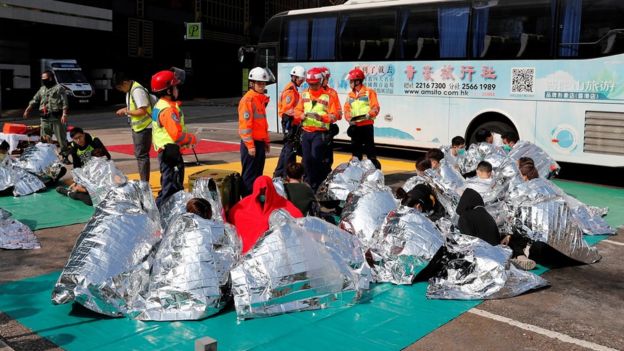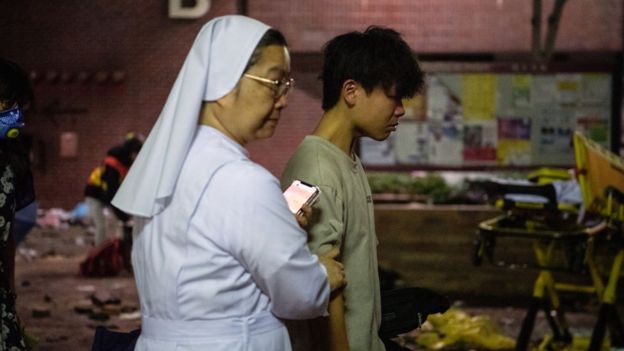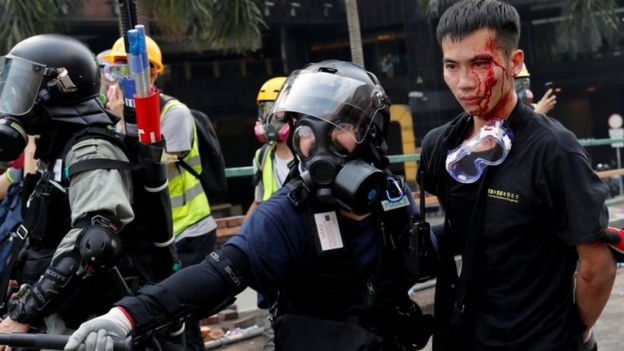About 100 protesters remain barricaded inside a Hong Kong university campus surrounded by police, as the standoff enters a third day.
Protesters inside Polytechnic University are said to be running low on supplies, with one lawmaker saying they could not last "another day".
Those inside expect to be arrested and charged with rioting if they walk out.
The university has turned into a battleground as anti-government protests show no signs of slowing down.
Tensions could be further inflamed by China condemning a decision by Hong Kong's high court to overturn a ban on face-masks.
 Media captionThese protesters attempting to leave PolyU met with tear gas
On Sunday night, police warned protesters they had until 22:00 (14:00 GMT) to leave the campus, saying they could use live ammunition if the attacks continued.
Police later moved in, surrounding the campus, leading to protesters throwing petrol bombs and firing rocks from catapults.
On Monday, dozens of protesters were arrested by police officers as they attempted to run from the campus. A small group managed to leave using rope ladders before being picked up by motorcycles.
Those arrested could be charged with rioting, which carries a penalty of up to 10 years in prison.
The violence at PolyU is one of the biggest flare-ups Hong Kong has seen since protests broke out in June.
The mostly young protesters have five key demands including an investigation into police brutality and universal suffrage.
But underpinning it all is the fear Hong Kong's unique identity is threatened by China.
Media captionThese protesters attempting to leave PolyU met with tear gas
On Sunday night, police warned protesters they had until 22:00 (14:00 GMT) to leave the campus, saying they could use live ammunition if the attacks continued.
Police later moved in, surrounding the campus, leading to protesters throwing petrol bombs and firing rocks from catapults.
On Monday, dozens of protesters were arrested by police officers as they attempted to run from the campus. A small group managed to leave using rope ladders before being picked up by motorcycles.
Those arrested could be charged with rioting, which carries a penalty of up to 10 years in prison.
The violence at PolyU is one of the biggest flare-ups Hong Kong has seen since protests broke out in June.
The mostly young protesters have five key demands including an investigation into police brutality and universal suffrage.
But underpinning it all is the fear Hong Kong's unique identity is threatened by China.
 Image copyrightREUTERS
Image captionProtesters receive medical attention after leaving PolyU
These are not the first batch of students to have left the campus.
In the early hours of Tuesday morning, more than 200 students below the age of 18 left, accompanied by various education officials, including high school principals.
Those under the age of 18 had their identities recorded and were let go. Around 100 adults also left and were immediately arrested.
Hong Kong leader Carrie Lam has called on all protesters to surrender, asking them to "come out peacefully and take instructions from police".
Separately on Tuesday, Hong Kong's new police chief took office.
Chris Tang said the force was not able to end the protests alone, saying the unrest would only end if society condemned the violence.
Image copyrightREUTERS
Image captionProtesters receive medical attention after leaving PolyU
These are not the first batch of students to have left the campus.
In the early hours of Tuesday morning, more than 200 students below the age of 18 left, accompanied by various education officials, including high school principals.
Those under the age of 18 had their identities recorded and were let go. Around 100 adults also left and were immediately arrested.
Hong Kong leader Carrie Lam has called on all protesters to surrender, asking them to "come out peacefully and take instructions from police".
Separately on Tuesday, Hong Kong's new police chief took office.
Chris Tang said the force was not able to end the protests alone, saying the unrest would only end if society condemned the violence.
 Image copyrightGETTY IMAGES
Image captionA nun leading a protester out of PolyU
Image copyrightGETTY IMAGES
Image captionA nun leading a protester out of PolyU
 Image copyrightREUTERS
Image captionA protester arrested while trying to leave the campus
The university then cancelled all classes for the rest of the term. Days later, protesters at PolyU also tried to block access to a key tunnel near the university.
Protests have also been held at other locations in Hong Kong.
Image copyrightREUTERS
Image captionA protester arrested while trying to leave the campus
The university then cancelled all classes for the rest of the term. Days later, protesters at PolyU also tried to block access to a key tunnel near the university.
Protests have also been held at other locations in Hong Kong.
 Media captionThese protesters attempting to leave PolyU met with tear gas
On Sunday night, police warned protesters they had until 22:00 (14:00 GMT) to leave the campus, saying they could use live ammunition if the attacks continued.
Police later moved in, surrounding the campus, leading to protesters throwing petrol bombs and firing rocks from catapults.
On Monday, dozens of protesters were arrested by police officers as they attempted to run from the campus. A small group managed to leave using rope ladders before being picked up by motorcycles.
Those arrested could be charged with rioting, which carries a penalty of up to 10 years in prison.
The violence at PolyU is one of the biggest flare-ups Hong Kong has seen since protests broke out in June.
The mostly young protesters have five key demands including an investigation into police brutality and universal suffrage.
But underpinning it all is the fear Hong Kong's unique identity is threatened by China.
Media captionThese protesters attempting to leave PolyU met with tear gas
On Sunday night, police warned protesters they had until 22:00 (14:00 GMT) to leave the campus, saying they could use live ammunition if the attacks continued.
Police later moved in, surrounding the campus, leading to protesters throwing petrol bombs and firing rocks from catapults.
On Monday, dozens of protesters were arrested by police officers as they attempted to run from the campus. A small group managed to leave using rope ladders before being picked up by motorcycles.
Those arrested could be charged with rioting, which carries a penalty of up to 10 years in prison.
The violence at PolyU is one of the biggest flare-ups Hong Kong has seen since protests broke out in June.
The mostly young protesters have five key demands including an investigation into police brutality and universal suffrage.
But underpinning it all is the fear Hong Kong's unique identity is threatened by China.
What is happening today?
An estimated 100 protesters still remain in PolyU, authorities have said. But a handful of protesters have been trickling out of the university, some suffering from hypothermia and leg injuries, according to news site SCMP. One protester said he decided to come out due to "hunger and cold", adding that many inside were "hurt without enough medical supplies". Pro-democracy lawmaker Ted Hui had earlier said protesters did not have enough supplies to "last another day". Another 16-year-old protester told Reuters that she chose to "surrender". "We have been trying to escape since yesterday morning. But then we couldn't find a way out [and] were afraid of being charged," she said. "This is the only way... I was quite desperate." Image copyrightREUTERS
Image captionProtesters receive medical attention after leaving PolyU
These are not the first batch of students to have left the campus.
In the early hours of Tuesday morning, more than 200 students below the age of 18 left, accompanied by various education officials, including high school principals.
Those under the age of 18 had their identities recorded and were let go. Around 100 adults also left and were immediately arrested.
Hong Kong leader Carrie Lam has called on all protesters to surrender, asking them to "come out peacefully and take instructions from police".
Separately on Tuesday, Hong Kong's new police chief took office.
Chris Tang said the force was not able to end the protests alone, saying the unrest would only end if society condemned the violence.
Image copyrightREUTERS
Image captionProtesters receive medical attention after leaving PolyU
These are not the first batch of students to have left the campus.
In the early hours of Tuesday morning, more than 200 students below the age of 18 left, accompanied by various education officials, including high school principals.
Those under the age of 18 had their identities recorded and were let go. Around 100 adults also left and were immediately arrested.
Hong Kong leader Carrie Lam has called on all protesters to surrender, asking them to "come out peacefully and take instructions from police".
Separately on Tuesday, Hong Kong's new police chief took office.
Chris Tang said the force was not able to end the protests alone, saying the unrest would only end if society condemned the violence.
 Image copyrightGETTY IMAGES
Image captionA nun leading a protester out of PolyU
Image copyrightGETTY IMAGES
Image captionA nun leading a protester out of PolyU
What's this about face masks?
Hong Kong had previously banned protesters from wearing face masks - but this was deemed "unconstitutional" by the city's high court on Monday. But now China has come out and condemned the high court's decision. It says it has the sole authority to rule on constitutional matters in the region - it is unclear what action, if any, China might take next. This is a large part of what the on-going protests in Hong Kong are about. Hong Kong is a part of China and many in the city fear that its freedoms - including judicial independence - are slowly being eroded.How did we get here?
Campuses had remained relatively free of violence during the Hong Kong protests - despite the movement being led mainly by students and young people. But after the death of a 22-year-old student, that changed. Last week, the Chinese University of Hong Kong became a battleground. Police say protesters threw petrol bombs on a major road near the university in an effort to stop traffic. Officers attempted to reclaim the road, leading to major clashes. Image copyrightREUTERS
Image captionA protester arrested while trying to leave the campus
The university then cancelled all classes for the rest of the term. Days later, protesters at PolyU also tried to block access to a key tunnel near the university.
Protests have also been held at other locations in Hong Kong.
Image copyrightREUTERS
Image captionA protester arrested while trying to leave the campus
The university then cancelled all classes for the rest of the term. Days later, protesters at PolyU also tried to block access to a key tunnel near the university.
Protests have also been held at other locations in Hong Kong.
Why are there protests in Hong Kong?
Hong Kong - a British colony until 1997 - is part of China under a model known as "one country, two systems". Under this model, it has a high degree of autonomy and people have freedoms unseen in mainland China. The protests started in June after the government planned to pass a bill that would allow suspects to be extradited to mainland China. Many feared this would undermine the city's freedoms and judicial independence. The bill was eventually withdrawn, but the demonstrations continued, having evolved into a broader protest against alleged police brutality, and the way Hong Kong is administered by Beijing.DISCLAIMER: The Views, Comments, Opinions, Contributions and Statements made by Readers and Contributors on this platform do not necessarily represent the views or policy of Multimedia Group Limited.
DISCLAIMER: The Views, Comments, Opinions, Contributions and Statements made by Readers and Contributors on this platform do not necessarily represent the views or policy of Multimedia Group Limited.
Latest Stories
-
Community Digital Fair inspires a new generation of digital thinkers in Ningo-Prampram
14 minutes -
Today’s Front pages: Thursday, June 19, 2025
19 minutes -
We’re monitoring all aspirants in the race – Justin Kodua declares
42 minutes -
We’re addressing our internal issues – Justin Kodua
52 minutes -
Works and Housing Minister inaugurates State Housing Company Board, two others
57 minutes -
Opoku-Agyemang engages NDC leadership
1 hour -
Justin Kodua attributes NPP’s 2024 loss to global wave against incumbents
1 hour -
NPP presidential primaries not skewed to favour any candidate – Justin Kodua
1 hour -
Parliament takes major step towards strengthening economic governance
1 hour -
IFC urges banks to increase lending for sustainable buildings
1 hour -
‘Be measured in commenting on… issues,’ Supreme Court nominee urges chiefs on bench
2 hours -
Governor Asiama urges banks to develop customer-centric products
2 hours -
Samini reveals Mahama and judiciary actions make him a happy Ghanaian
2 hours -
Ghana Armed Forces set to employ thousands soon – Defence Minister announces
2 hours -
Telecel Ghana Foundation donates 100 laptops to KNUST to support deprived students
2 hours

